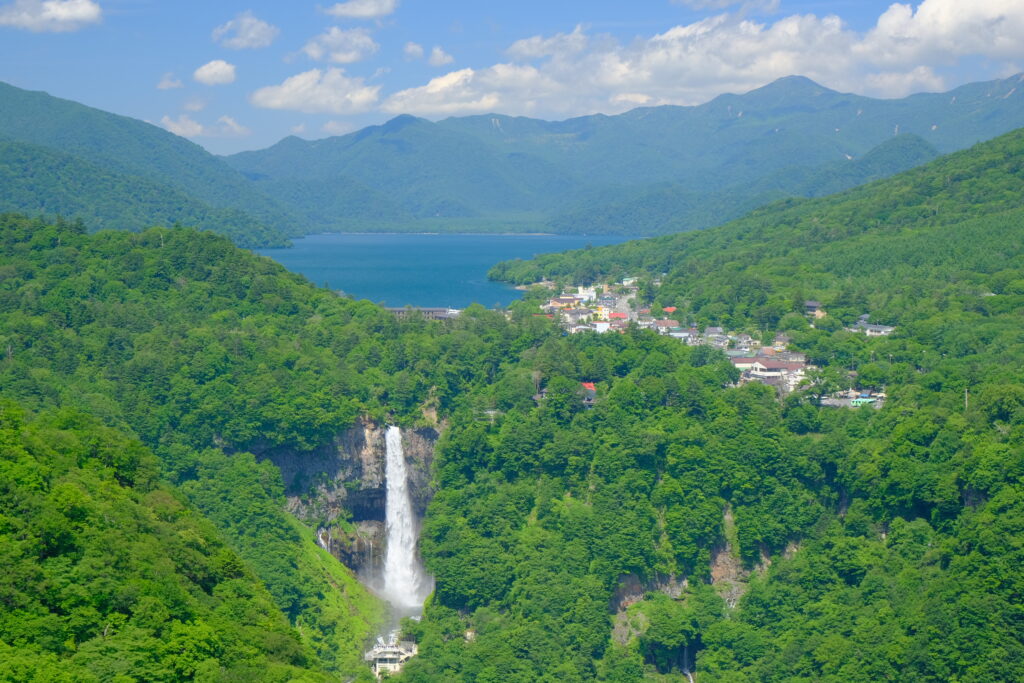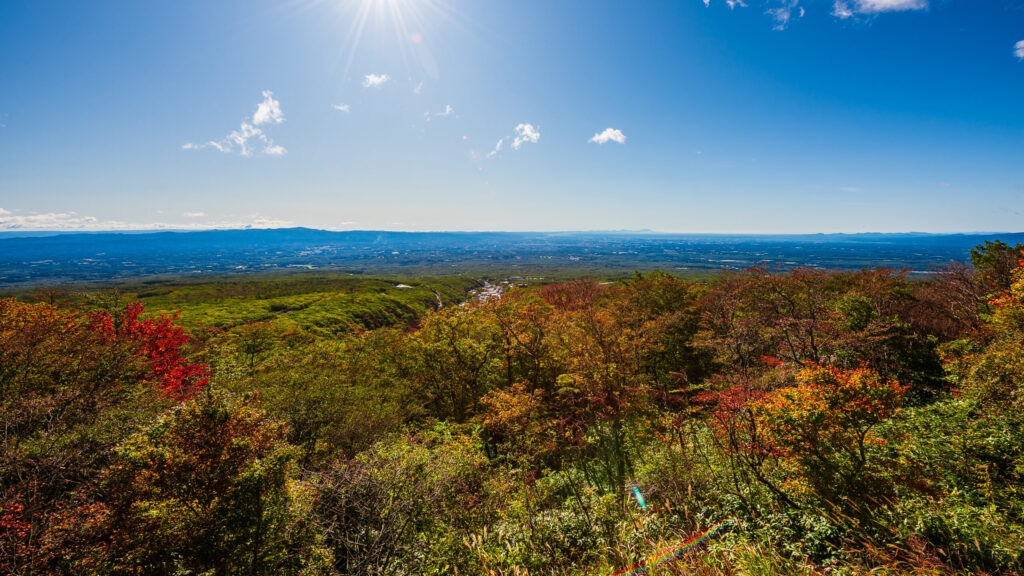Introduction to Tochigi Prefecture
Tochigi Prefecture is located in the northern part of the Kanto region. Easily accessible from the Tokyo metropolitan area, it is a popular tourist destination with a variety of attractions such as mountains rich in nature, hot springs, and historical buildings.

Geographical location
Tochigi Prefecture is located in the northern part of the Kanto region, bordered by Fukushima Prefecture to the north, Ibaraki Prefecture to the east, Gunma Prefecture to the south, and Saitama Prefecture to the west. The prefectural capital is Utsunomiya City.
History & Culture
Tochigi Prefecture has a long and prosperous history. Many historical buildings remain, such as Nikko Toshogu Shrine and the “Shrines and Temples of Nikko,” which are registered as a World Heritage Site. In addition, Tochigi Prefecture has its own unique culture, such as “Yuki-nonge,” which is said to have originated during the time of the Shimono Fujiwara clan, and “Mashiko pottery,” which was introduced by the Nabeshima family of feudal lords during the Edo period.
Tourist attraction
Tochigi is full of beautiful natural and historical sites.
Nikko Toshogu Shrine

Built in 1617, Nikko Toshogu Shrine is dedicated to Tokugawa Ieyasu, who unified Japan during the Warring States Period, and is registered as a World Heritage site for its ornate architecture.
Within the precincts of the temple, there are many attractions such as the gilded Yomeimon Gate and the five-story pagoda where the body of Ieyasu was enshrined. Visitors can also enjoy nature in each of the four seasons: ume (plum) grove in spring, colored leaves in summer, and gingko trees in autumn.
Nasu Highlands

The highlands are blessed with nature and offer beautiful scenery in each of the four seasons. In summer, it is a summer resort, and in winter, visitors can enjoy winter sports such as skiing and snowboarding.
Nasu Kogen also has amusement and theme parks such as Nasu Highland Park and Ashikaga Flower Park, where visitors can play all day long.
Kinugawa Onsen

Kinugawa Onsen is known as one of the largest hot spring resorts in the Kanto region, attracting approximately 2 million tourists annually.
The charm of Kinugawa Onsen is its rich natural environment. Lined with inns and hotels along the Kinugawa River valley, visitors can enjoy nature in all four seasons. Visitors can enjoy a variety of activities throughout the year, including cherry blossoms and fresh greenery in the spring, river bathing in the summer, autumn leaves in the fall, and skiing and snowboarding in the winter.
Kegon Falls

Kegon Falls is one of the three most famous waterfalls in Japan, with a drop of 97 meters. The sight of water cascading down from Lake Chuzenji is truly breathtaking.
Near the falls, there is a viewing platform and Kegon-no-taki elevator that allows visitors to view the falls up close. Visitors can enjoy beautiful scenery at any time of the year: fresh greenery in the spring, swallows swimming in the basin of the falls in the summer, autumn leaves in the fall, and icefalls in the winter.
Food culture
Tochigi Prefecture’s culinary culture is characterized by dishes that make the most of the ingredients produced by its rich natural environment. The following are some of the local dishes and specialties.
Utsunomiya gyoza

Utsunomiya City in Tochigi Prefecture is known as the city that consumes the largest amount of gyoza in Japan. Utsunomiya Gyoza,” which originated in Utsunomiya City, is one of the most popular gourmet foods in Japan.
Utsunomiya gyoza is characterized by its large size, a good balance of vegetables and meat, and thin, crispy skin. They also have a garlicky flavor that makes them very satisfying.
Nikko yuba

Nikko City, Tochigi Prefecture, is famous for its yuba. Nikko yuba is characterized by its elegant taste and rich flavor, which is created by using high-quality soybeans and the famous water produced in the clear streams of Nikko.
Yuba is a staple ingredient in Japanese cuisine and can be enjoyed in a variety of dishes. Raw yuba is usually served with wasabi, soy sauce, or ponzu (Japanese citrus juice). It is also used in a variety of dishes such as yuba rolls, yuba soba, and yuba tofu.
Kenchin Jiru

Kenchin Jiru, a local dish of Tochigi Prefecture, is a soup made with plenty of vegetables such as daikon radish, carrots, burdock root, and taro. This dish has been eaten in the Nasu region of Tochigi Prefecture since ancient times, and is also popular as a vegetarian dish. It is characterized by vegetables sauteed in oil and simmered in broth, and has a relaxing taste with the concentrated flavor of vegetables.
Sano Ramen

Sano ramen is the representative ramen of Sano City, Tochigi Prefecture. It is a simple ramen with a soy sauce-based broth topped with thin noodles, chashu pork, pickled bamboo shoots, naruto, and spinach, but it attracts many ramen fans because of its deep flavor.
Activities
There is a wide variety of activities to enjoy in Tochigi.
Hiking
Tochigi Prefecture offers a wide variety of hiking courses that can be enjoyed by both beginners and advanced hikers. Courses include those that take in Nikko Toshogu Shrine, Lake Chuzenji, and other sightseeing spots, as well as courses that allow you to fully enjoy the magnificent nature of Nasu Highlands. You can also enjoy nature in each of the four seasons.
Tour of a hot spring
Tochigi Prefecture is dotted with various hot spring resorts, such as Nikko and Nasu, each with its own unique characteristics.
Kinugawa Onsen: This is the most popular hot spring resort in the Kanto region and is characterized by its gorgeous atmosphere. With a wide variety of accommodations and restaurants, visitors can enjoy sightseeing and gourmet food.
Nasu Onsenkyo: Hot spring resorts are scattered over a large area of Nasu Highlands. Visitors can relax and unwind in a rich natural environment.
Shiohara Onsenkyo: A hot spring resort spread out along a valley, where visitors can enjoy nature in all four seasons. Rafting, canoeing, and other river activities are also popular.
We encourage you to visit the hot spring resorts that interest you.
Playing at Theme Parks
Tochigi Prefecture has many theme parks for families to enjoy. Nasu Highland Park offers a variety of attractions such as roller coasters and Ferris wheels for thrilling fun. Ashikaga Flower Park is famous for its seasonal flowers, and the winter illumination in particular is one of the largest in the world. Nasu Animal Kingdom is home to 3,000 animals of about 100 species, allowing visitors to get up close and personal with them.
We encourage you to visit Tochigi Prefecture and have fun at the theme parks.
Enjoy water activities
Tochigi Prefecture is rich in nature, with abundant rivers such as the Kinugawa and Naka Rivers flowing through the prefecture. For this reason, water activities such as rafting and canoeing are popular. Rafting offers a thrilling experience, while canoeing allows visitors to enjoy a relaxing river cruise while getting up close to nature.
Seasonal Recommendations
Tochigi has charms in all four seasons.
Spring
- Plum grove at Nikko Toshogu Shrine and cherry blossoms at Nasu Kogen: Approximately 500 plum trees are planted at Nikko Toshogu Shrine, and in early spring, plum blossoms of various colors such as white, pink, and red bloom, offering beautiful scenery. You can also take the ropeway at Nasu Kogen to view the rows of cherry trees from the air.
- Strawberry picking in Tochigi Prefecture: Tochigi Prefecture boasts the largest production of strawberries in Japan and is called the “Strawberry Kingdom. There are more than 300 strawberry farms in Tochigi Prefecture, where you can enjoy various varieties of strawberries.
Summer
- Kinugawa Onsen and Nasu Onsen Summer Resorts: Kinugawa Onsen and Nasu Kogen are popular as cool summer resorts. A stroll along the Kinugawa River is a great way to feel cool while bathing in negative ions. Nasu Kogen is also home to an amusement park and a zoo, making it a fun place for the whole family.
- Utsunomiya Gion Festival: This traditional festival is well known as a summer tradition in Utsunomiya. The festival is full of attractions, such as the parade of gorgeous floats and the passionate parade of portable shrines.
Autumn
- Autumn Foliage in Nikko National Park: The best time to view the autumn foliage in Tochigi Prefecture is usually from mid-October to late November. There are many autumn foliage viewing spots in Nikko National Park, including Lake Chuzenji, Kegon Falls, and Iroha Slope.
- Tochigi Prefecture grape picking: Tochigi Prefecture is famous for growing sweet and juicy grapes due to the large temperature difference between day and night. Especially from mid-September to mid-October, visitors can enjoy picking various kinds of grapes that are in season.
Winter
- Skiing and snowboarding: Tochigi Prefecture has ski resorts where even beginners can enjoy skiing, such as Hunter Mountain Shiobara, MAUNA, and Edelweiss Ski Resort.
- Illumination at Nasu Highland: Nasu Highland is transformed into a magical world of illumination in winter. Illumination events utilizing the vast expanse of Nasu Highlands are popular as a regular winter sightseeing spot.
Local Culture
Local culture in Tochigi is expressed through festivals and crafts.
Festival
Nasu Yoichi Festival: Held annually in Nasu Shiobara City in early August, this festival honors Nasu Yoichi, a military commander active in the Genpei War. The festival features a warrior parade, horseback archery, fireworks displays, and other events, and attracts many people.
Nikko Reiho Kaido Watarase Matsuri: Held annually in Nikko and Sano cities in early October, this festival has continued since the Edo period (1603-1868). The procession carrying the offering of the offering to Nikko Toshogu Shrine is reenacted, and the streets are filled with a festive atmosphere.
Traditional craft
- Yuki Tsumugi: This silk fabric has been produced since the Heian period (794-1192) and is characterized by its unique luster and beautiful colors. In Yuki City, there are workshops that continue to preserve the traditional techniques and stores that sell Yuki-tsumugi silk with modern designs.
- Mashiko Pottery: Founded in the late Edo period, Mashiko Pottery is characterized by its rustic texture and warm expression. Many pottery stores line the streets of Mashiko Town, and there are also spots where visitors can actually try their hand at making pottery.
Transportation
Access to Tochigi is very convenient.
Shinkansen
Access from Tokyo to Tochigi by Shinkansen takes about 3 hours and 30 minutes.
Railway
The train ride from Tokyo Station to Utsunomiya Station takes approximately 1 hour and 30 minutes.
Express Bus
Access from Tokyo to Tochigi by highway bus takes about 2 hours and 30 minutes.
Lastly
Tochigi Prefecture is a tourist destination where visitors can enjoy nature in all four seasons. In particular, it is a summer resort in summer, and in winter, visitors can enjoy winter sports such as skiing and snowboarding. Also, be sure to try some of Tochigi Prefecture’s unique gourmet foods, such as Utsunomiya gyoza and Nikko yuba.